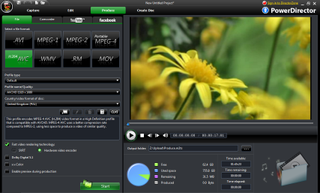ADVERTORIAL: ATI Radeon HD 4650/70: Top Value for Bottom Dollar
Into the Stream

We’ve already described how unified shaders can be programmed to perform a variety of previously pre-assigned tasks. This programmability concept has gone into hyperdrive over the last couple of years as “general-purpose GPU computing” (GPGPU) has emerged from the academic world into the consumer space. The idea is really just an extension of the type of offloading we see with video decoding. What work can the GPU do for the CPU? And in the case of stream computing, what work can the GPU do better?
Remember those 320 stream processors in the HD 4650 and 4670 cores? Any given number of those can be programmed on the fly to compute certain types of tasks that might have nothing to do with graphics or video. Once this data gets crunched, it can be exported and recombined with other work being done by the CPU. According to AMD, software that can benefit from this GPU-based “stream computing” possesses two key characteristics: “1. A high degree of arithmetic computation per system memory fetch. 2. Computational independence—arithmetic occurs on each processing unit without needing to be checked or verified by or with arithmetic occurring on any other processing unit.”
An early and extreme example is Stanford University’s Folding@home distributed computing project, which breaks up massive molecular analysis jobs into manageable pieces that can be sent to end-user systems, processed, then uploading back to the central servers for compilation. With many, many thousands of PCs working on these tasks in tandem, the Stanford team is able to process far more data than it ever could in a single server room. But because of the massively parallel computing architecture in AMD’s graphics processor, systems running GPUs with compatible GPGPU technologies, such as ATI Stream, can compute Folding@home workloads 20 to 40 times faster than having the CPU alone compute the same jobs.

As interesting and worthy as Folding@home might be, it’s not exactly a mainstream application. So why should consumers care if they have GPGPU support? Because now there are an increasing number of multimedia applications, including MediaShow Espresso and PowerDirector versions 7 and 8 from CyberLink, that leverage ATI Stream to perform consumer-level video editing and transcoding tasks and likewise achieve huge performance gains over CPU-only processing. See our June write-up (https://www.tomshardware.com/reviews/amd-stream-gpgpu,2335.html) for some early commentary and results on this point.

As of this fall, AMD is clearly signaling that it will transition its GPGPU efforts into supporting the more vendor-agnostic DirectCompute technology championed by Microsoft. The Stream brand will likely remain and become tied to DirectCompute, but as of today there are no publicly available applications that support DirectCompute (compatible with the ATI Radeon HD 58xx series) while several excellent apps support the ATI Stream technology found in the HD 4650 and 4670. If you work with video, having this GPGPU support could save you countless hours of rendering time.
Stay on the Cutting Edge
Join the experts who read Tom's Hardware for the inside track on enthusiast PC tech news — and have for over 25 years. We'll send breaking news and in-depth reviews of CPUs, GPUs, AI, maker hardware and more straight to your inbox.
-
mlcloud At least give us the links to some of the 4650/70 benchmarks... Other than that, great read, great recommendations, looking to upgrade my pentium 4, 1.4ghz 256mb (ddr). Was looking at using the HD4200 on the 785g series from AMD, but if I can make a true gaming computer out of it ... hm... tempting.Reply -
I'm waiting for a HIS HD4670 1GB to arrive soon. It even has HDMI output.Reply
Got it really cheap from newegg. It'll do fine with my Intel E5200. Nothing like a super gaming machine, but hope to play TF2 and L4D with good gfx. That's all i play atm.
-
tortnotes Advertorial? How much did AMD pay for this?Reply
Not that it's not good content, but come on. Doesn't Tom's make enough from normal ads? -
duckmanx88 mlcloud Was looking at using the HD4200 on the 785g series from AMD, but if I can make a true gaming computer out of it ... hm... tempting.Reply
on their gaming charts the 4670 is listed. plays FEAR 2 pretty well. i assume it can than handle all Source games as well but at lower resolutions, medium settings, no AA, the usual. -
Assuming I'm assembling a new system and the HD 4650/4670 is the most cost-effective graphics card... what then is the most cost-effective processor to pair with it?Reply
-
Good thing to see ATI marketing their 4650/4670.Reply
I was hoping to see more of their mid-range cards. -
WINTERLORD great article these are some nice cards for the price, i wonder though if you got 2 of them and tried to put them in a crossfire config. since they dont require a power source, other then the pci-e slot, would 2 of them cause any problems drawing all that current through the motherboard? kinda wondering if there would be any impact there.Reply -
Ati making great job. In my office there was need to meka PC with 6 individual monitors. Solution - mainboard asus p5q-e + 3 ati 3650 video cards with vga+DVI outputs. Great working very cheep in cost. Tried to meke the same with nvidia 8400gt - no result 4 monitors individual maximum. Ati - rulezzzReply
-
lien +Reply
Installed an Sapphire 4650 AGP on a backup system in August.
Overclocked it & almost pissed myself on how good the image quality was on that system.
Article confirms....
value based articles are refreshing
Most Popular

